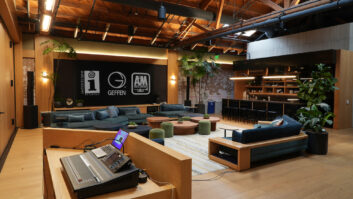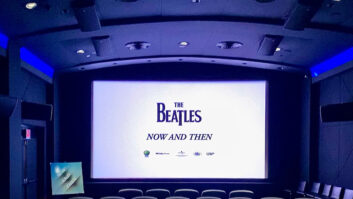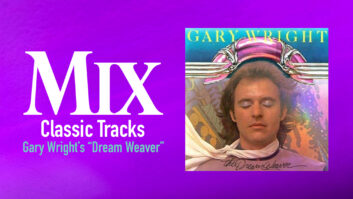
The new Neve 88R in the refurbished, re-wired Studio A.
Photo: Amber Sterling
Something very interesting has been going on for the last 18 months or so at the historic Capitol Records Tower and Studios in Hollywood. Although embroiled in uncertainty during that time due to the impending sale of parent company EMI to Universal Music, the studios, label archives, and overall facility headquartered at 1750 North Vine Street have all been part of an ambitious effort to position EMI Capitol on the leading edge of the current music industry trend toward both sonic and artistic quality.
The Creative Hub
EMI, of course, is one of the last remaining labels to own studios. Both Capitol and London’s Abbey Road are unquestionably historic treasures, temples of sound that encompass a rich heritage of quality. Capitol’s studios, for example, were designed in the 1950s to accommodate the debut of stereophonic recordings, and are well known for classic recordings by artists from Frank Sinatra, Nat King Cole and the Beach Boys to Ray Charles and Diana Krall. Now, the Capitol team is building on that imposing legacy of quality sound as the industry moves into the future.
“Capitol’s studios were purpose-built to make superior recordings for Capitol Records,” explains Dan McCarroll, president of Capitol Records. “We want to re-live that theme. Especially in today’s world, where almost anyone can get access to some kind of music-making software, having a true world-class studio at our fingertips is an incredible tool to help distinguish our recordings from everything else that’s out there.”
Among the three main studios, multiple mastering rooms and numerous other recording spaces housed in the multi-story building, a new philosophy aimed at maximizing creativity has taken hold.
“We want to ensure that the Tower and the studios are a place where artists can feel, and be, at their most creative,” says EMI Music EVP Barak Moffitt. “We also want to encourage serendipity in the creative process. On a daily basis, we have talent flowing throughout the building. People are making amazing, and sometimes unplanned, creative connections with each other. Now our goal is to let the industry overall know that we are building an innovative, active—and iconic—creative center where the Capitol historical legacy is also creating the legacy of the future.”
To do all this, the team started by going back to the basics. “We wanted an ‘artist first’ experience,” says Moffitt. “We started by tracking the steps of an artist working here and examining what their recording experience was like. We made room in the front of the parking lot for performers and creative professionals. We added welcome signs, along with badged entry and parking cards for our regular artist, musician, producer and engineer clients. And although the studios, of course, have private lounges, we also built attractive common spaces where people can interact—and that serendipity can happen.”
Several well-known producers and engineers have become artists-in-residence with personal studios in the Tower, among them Jon Brion, Greg Koller and Eric Cadieux, who work with McCarroll on a wide range of projects, and Niko Bolas, who moved into the Tower more than a year ago. Says McCarroll, “Artists need to be in an environment where experimentation is encouraged. Having Jon Brion and his team in the building has been amazing—whether it’s behind the console putting their mojo into a mix or working in the live room with an artist. When you get that kind of creativity going with your artists, you’d better make sure you’re recording.”

Capitol President Dan McCarroll with Capitol friends and crew, from left: Don Was, Barak Moffitt, Eric Caudieux, McCarroll, Greg Koller, Jon Brion and Drew Waters.
Photo: Amber Sterling
New songwriter rooms have also been designed and built to bridge the traditional lines between songwriter, producer, engineer and artist. “We see those lines blurring,” states Moffitt, “and we want to foster an environment where that can happen in the best possible way.” Equipped with high-quality recording gear, it’s now easy for elements of demo recordings to transition to masters. The rooms are also used for overdubs, providing an economical and low-pressure alternative for clients tracking and/or mixing in Capitol’s three main studios.
Capturing the Performance
Creating an environment where artists feel creative and inspired to perform to the best of their abilities is one thing. Capturing the performances of the music they create is another.
“If you don’t capture a performance with the highest of sonic integrity, you are not doing justice to the artist,” says Drew Waters, Head of Studios Strategy and Operations. “We want to help create music that is sonically where the artist intended it to be. That requires creative and technical innovation, continual research into protocol and best practices, and investment in infrastructure.”
Capitol in recent years has labored under the same economic pressures as every other label and recording studio. Tight cost controls put a hold on expenditures, and time and its normal wear and tear were starting to take a toll. In 2011, a bold decision was made to address equipment, acoustical and infrastructure issues in the studios, most notably with the rebuild and re-outfitting of Studio A, the Tower’s largest control room and recording space.
The refurbishing of Studio A was a collaborative effort with input from a committee of technicians and seasoned engineers, including mainstay Capitol client Al Schmitt, Bolas, film mixer Frank Wolf and many others. Along with acoustic and design renovations by Kevin Hughes and Art Kelm, a new Neve 88R console was installed and power and wiring were replaced from the ground up. Key to the project was incorporating the flexibility to accommodate today’s varied sessions and their different workflow styles, from orchestra and string recording sessions to multiple surround formats for film mixing, with attention also paid to the specific requirements for recording live rock and current trends in pop and urban genres.
“I’m so excited by what was done to Studio A,” Schmitt says. “I love the new Neve 88R board, the acoustics in the control room are better than ever, and it still has the magic that makes Capitol one of the great studios ever.”
Passionately Reviving the Heritage
The phrase “stewarding the music” is one you’ll hear frequently at Capitol these days. That initiative encompasses not only capturing performances but also the treatment of archival assets and a new emphasis on research and protocol.
“The discipline of capturing a performance extends to our digital archives, tape transfers and remastering procedures,” notes Moffitt. “Revitalizing our catalog is one of our core strategies. With catalog, the art of capturing a performance for digital formats often starts in the analog realm. But we also need to employ the metadata disciplines that are required to ensure future-proofing and the ongoing commercial potential of the recordings.”

Drums and percussion
Photo: Amber Sterling
An emerging jewel in the crown of this effort are recent Capitol and Blue Note catalog re-masterings. Much time was spent on R&D and testing of the archival signal chain and many of the resulting exquisite remasters, from classic Blue Note titles to masterworks by Frank Sinatra and Ella Fitzgerald, are now commercially available.
Renowned producer/musician Don Was, now President of the legendary Blue Note label, says, “It’s an honor and a thrill to be the caretakers of this musical legacy. We want to protect and serve the original intentions of the artists, engineers and producers without editorializing about what we may think they ‘should’ have done. The challenge is to maintain the feel of the original vinyl releases while reintroducing the transparency and depth of the original master tapes. So far the results are sublime!”
Quality, of course, is also about people. Technology and processes are ever changing, and technical and creative personnel must be able to maintain the kind of motivation and inspiration that allows them to continually go the extra mile. Capitol’s heritage and the skill sets required to maintain it provide an opportunity for the Tower to be a place where those skill sets—from live music recording to tape handling, vinyl cutting, and archival re-mastering—can be developed, nurtured, and passed on to the community at large as well as to coming generations.
“We are so fortunate that, on any given day, we are likely to have some of the world’s most legendary artists, producers, and engineers as clients,” comments Paula Salvatore, Capitol’s Senior Director, Studios, and the person in charge of booking and studio management. “Because of that, we have always had high standards for our employees. But also because of that, our employees get the advantage of working with, and learning from, the absolute best in the business.”
Adds Waters, “Whether it’s building our own gear, leveraging the knowledge base of our staff, or pushing the envelope to create new techniques and sounds, we want our staff to be able to innovate when opportunities present themselves, whether they are a technician, a mastering engineer, a tape transfer specialist or a studio engineer.”
Studios as Strategic Asset
In the most basic terms, one could suggest that a record label has a straightforward role: To discover and develop talent, and to connect that talent to successful outcomes—to help establish, and then deepen, the emotional connection between artist and fan, and to reward the artist for that connection.
“If you believe, as we do,” says Moffitt, “that the depth of the emotional connection between the artist and the fan is directly related to the quality of the listening experience, then it follows that it’s the label’s mandate to champion quality in the recording itself.”
So do fans need to be provided with an optimal audio experience on whatever platform or format they use to listen to their music?

“We can’t control how the consumer hears music,” Moffitt continues, “so it is our responsibility to understand the music and consumer ecosystems and to ensure that we provide the most optimal audio experience for whatever platform they are listening on—an iPod, a TV commercial, a movie soundtrack, a state-of-the-art auto sound system, or one of the hundreds of millions of mobile devices in use every day.
“In order to do that, for new works, we strive to start from the highest-definition source possible. For our catalog, we always start with the original tapes. The transfer process is paramount to the kind of quality we need to achieve; it’s not an afterthought.”
Underlying this effort are tightly engineered protocols related to managing the analog-to-digital chain, from electrical power to tape machines, cables, converters, software and conversion protocols at the highest resolution.
“It’s important to note that when it comes to re-issuing our catalog into the digital world,” says Moffitt, “we consider digital a format in its own right. We’re at a unique crossroads in music technology where we no longer have a physical media that influences the sound of the recording. And while digital has its challenges, there’s opportunity for high-definition formats where the listener can hear the artist’s performance—perhaps in the most transparent way possible since the advent of the recording.”
Ultimately, the team at Capitol recognizes that the studios are a valuable strategic asset—sort of a manufacturing floor for the company’s core product: music recordings. But, although they are a special place that nurtures creativity, they also need to earn revenue. The task is therefore to balance a sensible commercial approach with the fact that the studios are a unique creative asset.
”You can never stop getting better, and sometimes you’re not starting from where you’d like to,” concludes Moffitt. “In many ways we’re just getting started. We want to be a center of excellence and we need to help carry our cost with revenue. We do that through the studios, brand partnerships, Capitol Engineering where we offer engineering services outside the building, Capitol Mastering with mastering and transfer services, and Capitol Beacon, our newly launching, unattended, online mastering, engineering and transfer sessions.
“The industry in general is finally getting to a place where quality is becoming central to the discussion. We’re really excited about that, and about having the opportunity to start living that out with the privilege of Capitol Studios.”
Maureen Droney is Senior Executive Director of The Recording Academy Producers & Engineers Wing.







